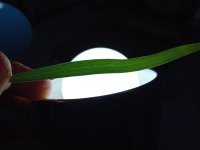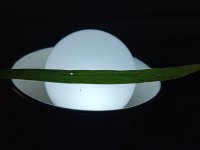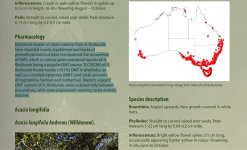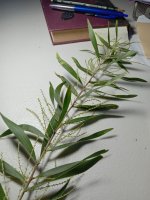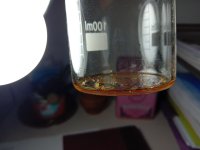It would get to sticky medium brown crystals after about 2 weeks. I tried to recrystalise but it took another 2 weeks to end up where it was and was mostly a waste of time. Much preferred without the other alkaloids. But definitely recommend trying the phenethylamines by themselves. It would be nice to see some clever person do a Column chromatography and then see what the phenethylamines/phenythylamine actually are/is. It would also be nice to hear some other trip reports.Thanks for sharing your experience @brendan
How was the extract after removing the alkaloids? Did you achieve a crystaline structure or did it remain an oil? Which don’t prefer? With other alkaloids or without?
-
Members of the previous forum can retrieve their temporary password here, (login and check your PM).
You are using an out of date browser. It may not display this or other websites correctly.
You should upgrade or use an alternative browser.
You should upgrade or use an alternative browser.
Research Acacia floribunda - Workspace and information
- Thread starter acacian
- Start date
Research done by (or for) the DMT-Nexus community
Migrated topic.
How do you know that what you removed were phenethylamines? Did you have the extract tested or do TLC? Do you mean attempting crystallizing was a waste of time or just that you don't really like the extract from this species?
I've also only been able to get sticky crystals.. but enjoy the effects very much. I find a dose of around 80mg is the sweet spot with floribunda. There should be a few trip reports on the nexus of floribunda. I know I posted some years back.
I've also only been able to get sticky crystals.. but enjoy the effects very much. I find a dose of around 80mg is the sweet spot with floribunda. There should be a few trip reports on the nexus of floribunda. I know I posted some years back.
Last edited:
I read somewhere that phenelthylamines pull at higher PHs than tryptamines and that this is a way of separating them from tryptamines. From the trip although it only lasted the same length as a DMT trip it was kinda like a black and white mescalin trip to be honest. And mescalin is a phenelthylamine. Not 100% sure if they were phenelthylamines and I have no clue about how to do TLCs or get things tested, which is what I am hoping someone else can do. Crystalising the DMT was not a waste of time but recrystalising didn't give me any better crystals, but I'm no expert. I do recommend that people at least remove the NMT from the extract as the trip is nicer in my opinion.How do you know that what you removed were phenethylamines? Did you have the extract tested or do TLC? Do you mean attempting crystallizing was a waste of time or just that you don't really like the extract from this species?
I've also only been able to get sticky crystals.. but enjoy the effects very much. I find a dose of around 80mg is the sweet spot with floribunda. There should be a few trip reports on the nexus of floribunda. I know I posted some years back.
Hm.. I'd have to differ in opinion here and recommend that they don't remove the NMT hehe. May as well embrace it or just find a species with a purer profile.. there's a point of tinkering where it will hardly be floribunda extract anymore. The extra alkaloids are what give these trees a unique signature IMO.. for me if I can get the extract refined enough that it vaporises well and is easily stored then I'm happy.. as long as the DMT effects are still there of course. If I'm after pure DMT I just work with a different species. I like floribunda so much because it has this interesting mix of alkaloids. But that's just me. 
Also are you 100% sure you removed the NMT? Was there a visible precipitate removed after bubbling with CO2? And did you do some kind of analysis on the removed precipitate? Its fairly speculative otherwise.. do you know for certain that NMT was the variable in your compared experiences?
Reason I say this is because backsalting floribunda extracts does clean them up considerably even without removing the NMT. That's the only way I've ever gotten crystallisation is with this method. But the other alkaloids were still in there .. and prevented the DMT from properly solidifying. I do think with Acacia floribunda backsalting extracts is essential. Thanks for sharing your experiments. Its jsut as likely you left behind a bunch of fatty acids that altered the experience as well.. your thoughts?
Also are you 100% sure you removed the NMT? Was there a visible precipitate removed after bubbling with CO2? And did you do some kind of analysis on the removed precipitate? Its fairly speculative otherwise.. do you know for certain that NMT was the variable in your compared experiences?
Reason I say this is because backsalting floribunda extracts does clean them up considerably even without removing the NMT. That's the only way I've ever gotten crystallisation is with this method. But the other alkaloids were still in there .. and prevented the DMT from properly solidifying. I do think with Acacia floribunda backsalting extracts is essential. Thanks for sharing your experiments. Its jsut as likely you left behind a bunch of fatty acids that altered the experience as well.. your thoughts?
Last edited:
I did have some incredible trips without removing the NMT and some incredible ones with only removing just the NMT but personally I wanted a cleaner trip. I had no access at the time to any other sources only floribunda. Yes there was always quite a lot of precipitate that came out with the CO2 . I'm just going off things I read about how to clean out different things. Whether they were those things or not I can't be 100% certain. I had no access at the time to any other sources only floribunda.
To me the raw floribunda extract trips felt like there was a black background to everything.
To me the raw floribunda extract trips felt like there was a black background to everything.
That's interesting.. I've not had that sensation with floribunda. It can be physically quite heavy for me but as far as visionary content I find it very colourful .. with plenty of impossible 'prismic' forms.. I find it a little more mysterious than other Acacias.. there's a sort of quietness to it sometimes. Have you compared it to other Acacia extracts? If so what are your thoughts?
I tend to need around 80mg to get really deep with it due to the large ratio of NMT... at that doseage it really shines.
I tend to need around 80mg to get really deep with it due to the large ratio of NMT... at that doseage it really shines.
CheeseCat
Established member
Recent find of some detailed anastomisation, likely the most interconnected nerve network I have seen on a floribunda phyllode so far. There's an abundance of tiny appressed hairs too, middle nerve slightly more prominent and this tree exhibits a whitish glow around the perimeter of its new growth which all seems very promising.
Attachments
Great comparison @CheeseCat .. while not conclusive, I’d say the more prominent anastomoses is a helpful indicator of the tryptamine form.
CheeseCat
Established member
Hey guys, here’s an interesting paragraph from Entheogenisis:
“Published studies of plant material from A. floribunda have reported mostly tryptamine and traces of phenethylamine but have not reported the occurrence of DMT, which is curious given anecdotal reports of A. floribunda being a popular DMT source. TLC/GCMS of A. floribunda found mostly (<0.1%) DMT in phyllodes, as well as n-methyltryptamine (NMT) and small amounts of tryptamine, harman and norharman. Reports suggest DMT content of A. floribunda varies substantially between populations, with some populations seeming to be entirely inactive.”
So published studies suggest some floribunda may not contain DMT but do contain other tryptamines/phenethylmines. Is it possible then, that someone inexperienced drinking a floribunda brew might mistakenly assume they are experiencing DMT but in fact it’s a variety of other tryptamines/phenethylmines consisting of little to no DMT?
“Published studies of plant material from A. floribunda have reported mostly tryptamine and traces of phenethylamine but have not reported the occurrence of DMT, which is curious given anecdotal reports of A. floribunda being a popular DMT source. TLC/GCMS of A. floribunda found mostly (<0.1%) DMT in phyllodes, as well as n-methyltryptamine (NMT) and small amounts of tryptamine, harman and norharman. Reports suggest DMT content of A. floribunda varies substantially between populations, with some populations seeming to be entirely inactive.”
So published studies suggest some floribunda may not contain DMT but do contain other tryptamines/phenethylmines. Is it possible then, that someone inexperienced drinking a floribunda brew might mistakenly assume they are experiencing DMT but in fact it’s a variety of other tryptamines/phenethylmines consisting of little to no DMT?
Attachments
Hey @CheeseCat ! Yes this is indeed the case. Again, active forms are consistent and decent yielding - but there are a number of inactive forms which are probably more common than the active one. So brews should not be consumed unless you already have extracted DMT from the tree ideally several times and know it pretty well. I don't think flori is a particularly toxic species anyways but if you haven't had success with it I would not be brewing it.Hey guys, here’s an interesting paragraph from Entheogenisis:
“Published studies of plant material from A. floribunda have reported mostly tryptamine and traces of phenethylamine but have not reported the occurrence of DMT, which is curious given anecdotal reports of A. floribunda being a popular DMT source. TLC/GCMS of A. floribunda found mostly (<0.1%) DMT in phyllodes, as well as n-methyltryptamine (NMT) and small amounts of tryptamine, harman and norharman. Reports suggest DMT content of A. floribunda varies substantially between populations, with some populations seeming to be entirely inactive.”
So published studies suggest some floribunda may not contain DMT but do contain other tryptamines/phenethylmines. Is it possible then, that someone inexperienced drinking a floribunda brew might mistakenly assume they are experiencing DMT but in fact it’s a variety of other tryptamines/phenethylmines consisting of little to no DMT?
Also, I have sent DMT containing floribunda material to these guys to have analysed and they found it it had like 0.04% DMT and similar NMT + trace harman which is plainly wrong (the ratios about right but the amounts are grossly under what is in the plant). So personally I think something is very off in their testing method.. 3 hrs in methanol with sonification with floribunda phyllodes doesn't seem to work. I've now sent three different samples from 3 different trees - all of which I've had great results with and gone deep hyperspace.. nothing found on their end. Until I see them use a known A/B extraction method for DMT containing phyllodes (instead of some obscure procedure that no one uses) their findings are pretty meaningless to me..
Last edited:
CheeseCat
Established member
Cheers @acacian. So these other tryptamine and phenethylamine compounds are the reason you prefer toluene or DCM for extracting?
Have you noticed any experiential difference between White Willow, NSW QLD Border and Small Seed flori? Alkaloid profiles seem similar?I've now sent three different samples from 3 different trees - all of which I've had great results with and gone deep hyperspace.. nothing found on their end.
You can only assume their method isn't aggressive enough to extract the compounds? Perhaps reliable for some acacia but not others.So personally I think something is very off in their testing method.. 3 hrs in methanol with sonification with floribunda phyllodes doesn't seem to work
61pete
Established member
Sonication does seem pretty legit though. I had no idea you could extract that way:
I've been reading "Extraction Technologies for Medicinal and Aromatic Plants" and on pg28 they say;
1.2.1.9
Ultrasound Extraction (Sonication)
The procedure involves the use of ultrasound with frequencies
ranging from 20 kHz to 2000 kHz; this increases the permeability of cell
walls and produces cavitation. Although the process is useful in some cas-
es, like extraction of rauwolfi a root, its large-scale application is limited due
to the higher costs. One disadvantage of the procedure is the occasional but
known deleterious effect of ultrasound energy (more than 20 kHz) on the ac-
tive constituents of medicinal plants through formation of free radicals and
consequently undesirable changes in the drug molecules.
Even the cheap 30w ultrasonic cleaners are 22kHz to 48 kHz.
Also heat is going to be a problem.
I was doing liposomal Vit C some years ago and had to frequently put the entire contraption in the fridge to cool down as soon as it reached 35ºC because Vit C is heat sensitive.
Heres the model I used, the Aoyue 9050, 50w on high setting with a 40kHz frequency.
It also very rapidly made pinholes in a sheet of Al foil in a water bath, so Id be concerned as to how it'd affect the molecule.
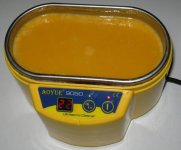
aizoaceous
Titanium Teammate
I've extracted frozen and thawed Phalaris by sonication in acidified water on a normal ultrasonic cleaner. The results (by HPLC) agreed closely with extraction by bead beating in a centrifuge tube shaken on a reciprocating saw, and also with larger-scale extractions by various means. I'm working mostly with 5-MeO-DMT, but there's also some DMT present. I don't see any evidence that either alkaloid was degraded by the sonication.
That said, sonication alone doesn't effectively extract from all plant material. For example, it extracts almost nothing from thick, succulent leaves like my Sceletium. I'd expect a professional lab to prefer sonication where possible, but they should confirm that it's working by comparison to other methods, ideally including immediate lyophilization and powdering (or something similarly mechanically aggressive).
Three hours is an unusually long time to sonicate, perhaps suggesting they got bad recovery with shorter times and that their method is thus marginal. If asked, then they should be able to explain why they thought that method was suitable, and if unable then acknowledge the potential issue and perhaps retest. I've unfortunately never worked with any Acacia myself.
I use my ultrasonic cleaner constantly, both to sonicate and simply as a temperature-controlled water bath for evaporation, hot pulls, etc. Beyond extracting from plant material, sonication is effective in dissolving almost anything, especially sticky resins or gums. I wouldn't expect moderately (like 50 C) elevated temperature to hurt these tryptamines, but if low temperature is desired then you can just put ice in the bath.
That said, sonication alone doesn't effectively extract from all plant material. For example, it extracts almost nothing from thick, succulent leaves like my Sceletium. I'd expect a professional lab to prefer sonication where possible, but they should confirm that it's working by comparison to other methods, ideally including immediate lyophilization and powdering (or something similarly mechanically aggressive).
Three hours is an unusually long time to sonicate, perhaps suggesting they got bad recovery with shorter times and that their method is thus marginal. If asked, then they should be able to explain why they thought that method was suitable, and if unable then acknowledge the potential issue and perhaps retest. I've unfortunately never worked with any Acacia myself.
I use my ultrasonic cleaner constantly, both to sonicate and simply as a temperature-controlled water bath for evaporation, hot pulls, etc. Beyond extracting from plant material, sonication is effective in dissolving almost anything, especially sticky resins or gums. I wouldn't expect moderately (like 50 C) elevated temperature to hurt these tryptamines, but if low temperature is desired then you can just put ice in the bath.
Thanks for your comments, @61pete and @aizoaceous .. sounds like they should be employing a few different methods for confirmation.
The one that has me stumped is their finding with the dwarf variety floribunda which I mentioned earlier in the thread, as they analyzed both the phyllodes and the extract and came up with nothing. The bark extract from another tree they found around 20% DMT, 25% NMT.
The sonification is one thing that clearly isn’t working well in their analysis of plant material. But then the extract analysis I have no idea. They found the dwarf variety extract to virtually contain no DMT and 8% NMT. This I’m confused by and leads me to wonder if there’s something up on my end .. the only possible thing I can think of is that there was residual DMT in my vaporgenie when tested as some DMT can drip down the glass. As for the other trees they tested.. they’re solid and have been tested multiple times and used used on many occasions and other people have also found them to be good.. they only tested the plant material of those. And their findings seem to be consistently in the 0.03-0.04 range.. so these figures do not represent what is in these trees.
The one that has me stumped is their finding with the dwarf variety floribunda which I mentioned earlier in the thread, as they analyzed both the phyllodes and the extract and came up with nothing. The bark extract from another tree they found around 20% DMT, 25% NMT.
The sonification is one thing that clearly isn’t working well in their analysis of plant material. But then the extract analysis I have no idea. They found the dwarf variety extract to virtually contain no DMT and 8% NMT. This I’m confused by and leads me to wonder if there’s something up on my end .. the only possible thing I can think of is that there was residual DMT in my vaporgenie when tested as some DMT can drip down the glass. As for the other trees they tested.. they’re solid and have been tested multiple times and used used on many occasions and other people have also found them to be good.. they only tested the plant material of those. And their findings seem to be consistently in the 0.03-0.04 range.. so these figures do not represent what is in these trees.
Last edited:
aizoaceous
Titanium Teammate
I should emphasize that your lab probably did perform that validation at some point, or at least is following a method published by someone who performed that validation. The question of whether a new sample is similar enough to the sample used for that validation is just fuzzy. "Any leaf" is clearly too broad a category, but is "any Mimosoid leaf"? "Any Acacia leaf"? All the way to the species? It's a lot of work to re-validate, but it doesn't take much to get a difference--I've seen different recovery within Phalaris brachystachys grown from the same batch of seeds, I think just from environmental factors, a sturdier and thus harder-to-extract leaf under more favorable growing conditions.Thanks for your comments, @61pete and @aizoaceous .. sounds like they should be employing a few different methods for confirmation.
If their sonication is recovering badly, then I expect they'd want to know. I would definitely advise them of the discrepancy, both for your own benefit and to save others from future misleading results.
CheeseCat
Established member
Hey @acacian, floribunda is described as having solitary or twinned flower spikes. I found an interesting tree yesterday that has some groupings of 3. Would this be consider floribunda still?
Also, would you be inclined to harvest a tree during flowering or post flowering? I’ve read mixed opinions on when the tree is most active…
Lastly, have you ever made an extract that you didn’t like? I ask this because the flori extract I currently have gives me a really uneasy feeling on the come-up. It’s a very scattered, panicky weird sensation that makes it hard to settle into the experience. I’m considering the possibility that the tree has some strange alkaloids in it? I’ve compared it to mimosa DMT and the mimosa is much more mellow and euphoric, without the crazy feeling...
Also, would you be inclined to harvest a tree during flowering or post flowering? I’ve read mixed opinions on when the tree is most active…
Lastly, have you ever made an extract that you didn’t like? I ask this because the flori extract I currently have gives me a really uneasy feeling on the come-up. It’s a very scattered, panicky weird sensation that makes it hard to settle into the experience. I’m considering the possibility that the tree has some strange alkaloids in it? I’ve compared it to mimosa DMT and the mimosa is much more mellow and euphoric, without the crazy feeling...
Attachments
CheeseCat
Established member
GraemeCarl
Rising Star
Fantastic tip re: the dissolving of goo @aizoaceous !I use my ultrasonic cleaner constantly, both to sonicate and simply as a temperature-controlled water bath for evaporation, hot pulls, etc. Beyond extracting from plant material, sonication is effective in dissolving almost anything, especially sticky resins or gums. I wouldn't expect moderately (like 50 C) elevated temperature to hurt these tryptamines, but if low temperature is desired then you can just put ice in the bath.
I've had a tiny craft bottle with a layer of polymerized Flori goo sitting in IPA for 7 years in the hope it would eventually dissolve enough for me to get it out of the bottle, well it never did.
I just now added some more IPA to fill the bottle again and then sonicated it for a couple of minutes and was very very happy to see the entire remnants have moved from the glass surface into the now reddish IPA.
Of course it may not be truly *dissolved*, but for the purposes of getting it out of the bottle, this is brilliant!
I have number of other sample bottles from various experiments over the years that are going to get the same treatment.

